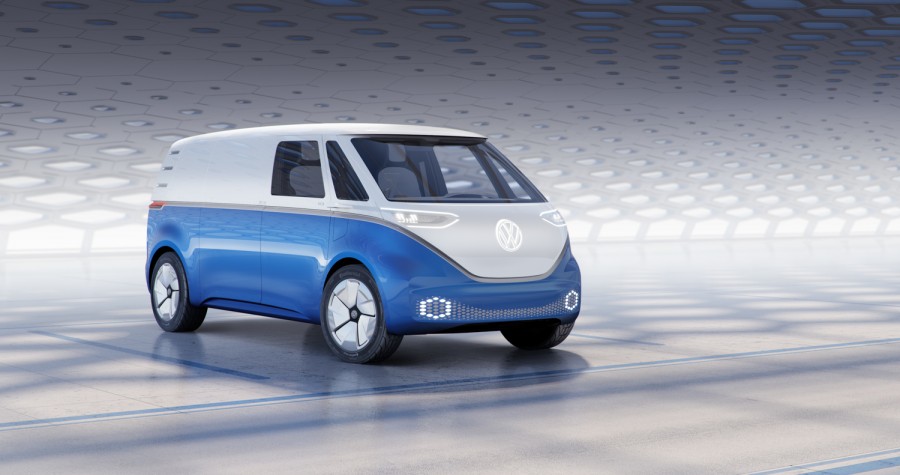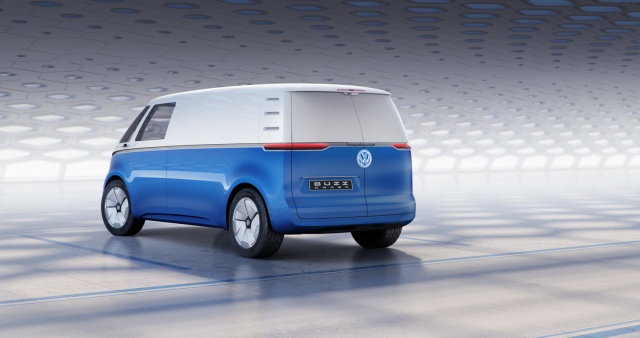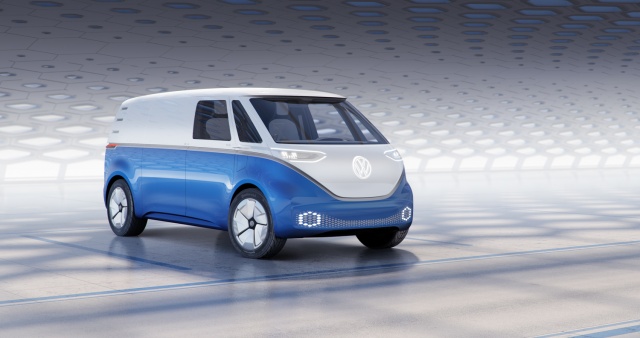What's the news?
We've already seen the Kombi version - the one with seats and windows - but now here's Volkswagen's all-electric I.D. Buzz in its proper, workhorse, Cargo version. A van, in other words, but when do you last remember seeing a van this cool?
Revealed as a concept at the IAA Commercial Vehicles show in Hannover, the I.D. Buzz Cargo is based on the same MEB electric car platform as the upcoming new I.D. hatcback and I.D. Crozz SUV. That means you can stuff it full enough of batteries to give it a 500km one-charge range, but Volkswagen says that one of the Cargo's core strengths is its scaleability. That means you can have just enough battery to do the job you need, with ranges ranging from 330km to the full-fat 500km.
Volkswagen has already shown off its ultra-long (5.9-metre) electric e-Crafter, which can carry a payload of up to 1.75 tonnes. The I.D. Buzz Cargo is a size down from that, so basically a potential electric replacement for the current T6 Transporter. As a concept, the maximum load weight of the Cargo is 800kg, but you will be able to fit plenty in - Volkswagen Has extended the rear overhang so that the Cargo is 106mm longer than the I.D. Buzz passenger version shown last year.
Aside from fitting front doors and a sliding side door that open electrically, Volkswagen has also given the Cargo a solar panel roof, which it says can potentially extend the van's range by as much as 15km. Another innovation is that it can be used by multiple drivers, thanks to a digital key which can be sent to a smartphone.
As with the T6 Transporter, the Cargo is a three-seater, with an individual driver's seat, and a bench two-space passenger seat. The middle portion of that seat folds flat, which opens up a workspace for either the driver or passenger, and there's even an integrated laptop computer. You can use that on the move, too, as the Cargo is supposedly setup for Level Four autonomous driving, which means you can have your hands and eyes off and let the van drive.
Once the autonomous drive is engaged, the driver's seat can swivel 15 degrees towards the centre of the car, the steering wheel and pedals fold away, and it's easier to use that integrated laptop.
There's no instrument panel in the Cargo. Instead, all of the information you need - from speed to sat-nav directions to the state of the battery - is projected onto a 3D augmented reality display in the windscreen. There is a portable tablet, which attaches to the centre console, to provide easy-access controls for things such as climate control. The rest of the Cargo's controls are located on a touchpad which forms the centre of the steering wheel. Conventional door mirrors are replaced by rear-facing cameras, which have displays integrated inside the cabin.
Even the loadspace has been tech-nified. Volkswagen says that it's bringing the 'Internet Of Things' into the cargo bay, with a smart shelving system that monitors what's been loaded on board, and which allows the company operating the Cargo van to track each item inside as it heads towards its point of delivery.
There's even a smart lighting system inside, which illuminates the interior shelves at the right point for the next item that's on the delivery list. That list can be updated and changed on the fly, either by the driver, or by the vehicle's home office.
From the driver's point of view, the Cargo is actually rear-wheel drive and, because its electric motor is integrated with the rear axle, technically it's rear-engined too, just as was the original Type Two 'Bulli' in 1949. There will be a two-motor, four-wheel drive version too, and thanks to the clever axle design, and the lack of a bulky petrol or diesel engine, and the fact that it has rear-wheel steering, the Cargo has a very tight 10-metre turning circle.
The Cargo can also double up as a mobile workshop. The rear doors open wide, allowing an integrated workbench to be folded out, and there's 230-volt power sockets so that you can connect any power tool you like.
Battery power ranges from 48kWh to 111kWh depending on how much one-charge range you need, and the Cargo has been setup to be compatible with next-generation 150kW ultra-rapid chargers, which can give an 80 per cent charge in just 15 minutes, although Volkswagen says that it expects the van to be mostly charged at HQ depots overnight. Its top speed is limited to 160km/h.
On the outside, while it has the classic styling of its 1950s forebear, the Cargo has some technical tricks to play with its exterior too. Those LED lights, for example, can just be lights, or they can use their multiple lighting elements to act as 'eyes' that can communicate with other road users, especially pedestrians, when the van is in autonomous mode.
Production chances? Pretty good, we'd say. Volkswagen is serious about its electric revolution, and when the I.D. Buzz Cargo looks this cool, this immediately appealing, surely they'd be nuts not to make it, right?



